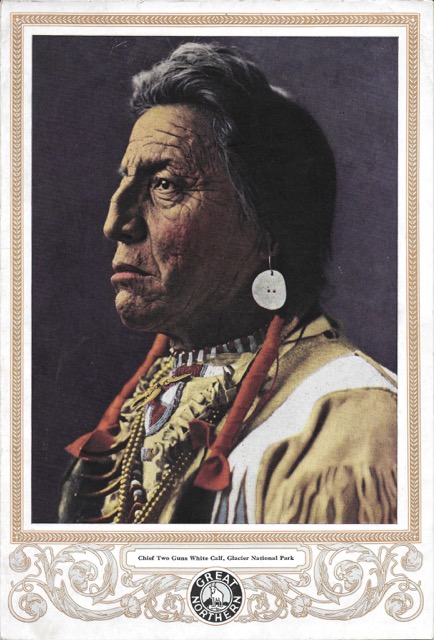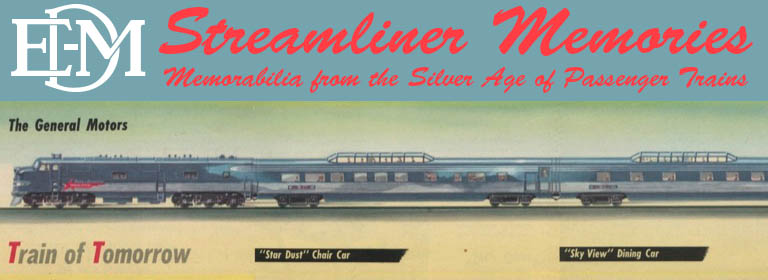The black-and-white photograph on which the colorized image on this menu was based was taken by Thomas Magee, a postmaster in Browning, Montana who was married to a Blackfeet woman. As previously noted here, Great Northern publicists claimed that Two Guns White Calf was the model for the face on the Indian head nickel, but that almost certainly wasn’t true.
 Click image to download a 2.9-MB PDF of this menu.
Click image to download a 2.9-MB PDF of this menu.
Dated August, 1925, this dinner menu offers chicken pot pie or a baked ham dinner, each for 75 cents (about $11 today). There is also a fish dinner and a vegetable dinner, but the chicken pot pie and ham are illustrated by colorful graphics that — at least in the case of the ham — almost certainly do not reflect what would be served to diners.
Instead of saying anything about Two Guns White Calf, the back cover has a quote by James J. Hill taken from a book by Elbert Hubbard, who — among other things — wrote a series of books called Little Journeys to the Homes of the Great. One of his little journeys took him to Hill’s house (you can read it in volume 11, starting on page 399). But this quote came from a scrapbook collected by Hubbard and published after his death on the last voyage of the Lusitania.
This menu is from the collection of the same Streamliner Memories reader who contributed the images of the Indian basket grass menu.

Well, somebody was certainly against any regulation. I wonder why?
Its worth noting that at the time this was published, the New Haven was reeling from the costs incurred from over-charged contractors with connections to senior management. This prevented it from completing planned and needed improvements, like completing the electrification to Boston and linking several branch lines together to complete the rail link along the South Coast of Massachusetts.
The lack of regulation certainly accomplished a lot, but it also wasted a great deal of resources, and vastly enriched a tiny handful of people through dishonest means-there’s a reason that Mark Twain called it “The Gilded Age”-because the wealth was only skin-deep.
Legislative “nuisance lines” attempting block construction of competitors cost millions of dollars. The Pennsylvania actually graded a route in direct proximity to the Reading’s Royal Blue Line through New Jersey for the sole purpose of trying to block it-the route shows up on Google Maps Terrain View to this day.
Likewise, the Reading operated a route to Atlantic City that was no more than 30 feet from the Pennsylvania’s line for half of its stretch. There was little to no economic sense for many of these projects.
Many companies tried to block streetcars out of fear of competition.
Other routes were pushed out into whatever new Gold Rush territory existed only to open after the mines ran out (though that would have probably happened regardless of regulation).